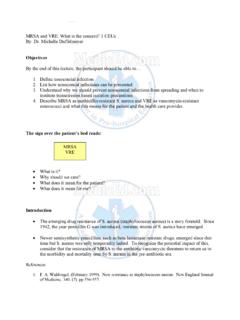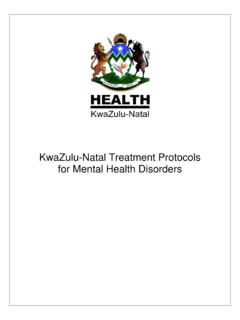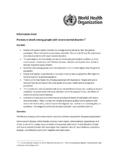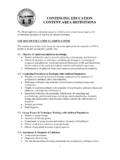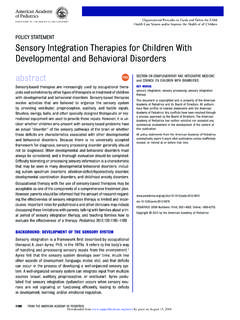Transcription of Altered Mental Status in the Geriatric Patient - …
1 Altered Mental Status in the Geriatric Patient By: James Scliopou, , NREMT-P. Copyright 2004. Objectives Define Altered Mental Status List techniques of assessing the elderly Patient with Altered Mental Status List the signs, symptoms, and treatment of the elderly Patient with Mental Status change related to Alcohol and drug abuse Acidosis Seizure disorder Metabolic disorders Cardiovascular disease Medication and non-medication related toxic exposures Stroke Infection Introduction Altered Mental Status (AMS) in the Elderly Patient What is Altered Mental Status ?: A term that can describe both the level of alertness or consciousness and/or Alterations in cognitive function (Ann Emerg Med). How is AMS identified? Assessment AVPU. Physical Exam Assessment History Past Medical History Obtain as much of the Patient 's medical history as possible directly from the Patient .
2 Determine if the Patient is functioning at a decreased level of awareness than normal. If the Patient is unable to provide the necessary information: Ask a family member, caregiver, or medical personnel Check for medical alert identification Check for medical information sheet ( on refrigerator). Check surrounding environment ( living quarters, alcohol bottles or drug paraphernalia). Assessment AVPU. Alert: awake and oriented, opens eyes. Verbal Stimuli: responds to voice by opening eyes, moaning, moving. Painful Stimuli: responds to painful stimuli, pinch of fingernail, sternal rub. Unresponsive: no response to any stimuli Assessment DO NOT assume that a confused, disoriented Patient is just senile, thus failing to assess for a serious underlying problem.
3 (Bledsoe , 2001). Assessment Once the initial level of responsiveness has been established, it may be helpful to use the mnemonic AEIOU-TIPS to identify some of the causes of Altered Mental Status . T Trauma, Toxins, A Alcohol, Acidosis Tumor E Epilepsy, Endocrine I Insulin I Infection P Psychosis, Poison O Overdose, Opiates S Stroke, Seizure U Uremia (kidney failure). Neuro Thorough neuro exam Focal neuro deficits (stroke). Facial droop Unilateral weakness Asterixis (metabolic disorders, liver failure, dilantin or other toxicity). Pupils dilated, pinpoint, sluggish, unequal Narcotics, brain swelling or hemorrhage, other disorders Assessment Physical Exam General Expose any hidden injuries Meningeal signs (stiff neck)indicating meningitis or subarachnoid hemorrhage Skin findings Pale (anemia/ blood loss).
4 Track marks (drug abuse). Fever (infection). Rash (infection). Cardiovascular findings Bradycardia/Tachycardia Hypotension/Hypertension Abnormal pulses or pulsatile abdominal mass (AAA). Respiratory findings Kusmal respirations (deep heavy breathing) indicating a metabolic acidosis such as diabetic Ketoacidosis Any respiratory distress may cause Mental Status changes by causing hypoxia or hypercarbia Causes & treatment A Alcohol, Acidosis Mental Status changes may occur because a Patient may have ingested too much alcohol, is withdrawing from alcohol or drugs ( delerium tremens), or has been using street drugs. Another cause may be acidosis, or the condition where there is a buildup of acid in the blood stream or the loss of bicarbonate in the blood stream that raises the pH.
5 Causes & treatment A Alcohol, Acidosis Alcohol Wernicke's Syndrome (Wernicke's Encephalopathy) loss of memory and disorientation usually due to a chronic intake of alcohol and a diet lacking in thiamine. Signs & Symptoms: Acute onset; reversible, affects CNS. Ataxia (lack of muscle coordination). Eye muscle weakness, Nystagmus (involuntary movement of the eyes). Mental confusion Mechanism: Thiamine deficiency affecting only some patients , the alcohol decreases the effectiveness of an enzyme in the brain to metabolize cerebral glucose, that leads to the above symptoms (Cotran, Kumar, & Robbins, 1999). Causes & treatment Alcohol continued treatment : 100mg Thiamine IV or IM. Follow local protocols or contact medical direction Korsakoff's Psychosis/Syndrome memory disorder, more severe than Wernicke's, usually long-term Signs & Symptoms: Memory impairment Disorientation, delirium, delusions Hallucinations, insomnia Bilateral foot drop Pain on pressure over long nerves Mechanism: Direct toxicity (of ethanol) from long-term use of alcohol and thiamine deficiency.
6 Causes & treatment Korsakoff's Psychosis/Syndrome continued treatment : 100mg Thiamine IV or IM. Follow local protocols or contact medical direction Note: Korsakoff's psychosis/syndrome may not readily respond to the administration of thiamine. It is also difficult to diagnose new onset of Korsakoff's in the pre- hospital setting without knowledge of past medical history. Always follow local protocols or contact medical direction. Causes & treatment Acidosis Types of Acidosis Respiratory acidosis retention of CO2 caused by inadequate ventilation. Diabetic ketoacidosis buildup of ketone bodies in advanced stages of diabetes mellitus. Lactic acidosis buildup of lactic acid in the blood due to poor perfusion and oxygenation of vital organs. Metabolic acidosis a decrease of pH in the body due to the retention of acids or a lack of bicarbonate.
7 Can be caused by vomiting, diarrhea, diabetes, or medications. Renal acidosis buildup of phosphoric and sulfuric acids due to renal failure or renal tubular diseases. Causes & treatment Signs & Symptoms: Confusion Lethargy Drowsiness Headaches Muscle tremors Blurred vision treatment Respiratory acidosis Improve ventilation, high-flow oxygen. Diabetic ketoacidosis Fluids, insulin as directed Metabolic acidosis Fluids, control any seizure activity. Renal acidosis Monitor Patient for changes in Mental Status or respiratory rate. Patient may receive sodium bicarbonate at the hospital. Causes & treatment E Epilepsy, Endocrine Epilepsy repeated seizure activity Prevalent in 2-3% of population, especially children and elderly over the age of 70 (Taber, Thomas, & Venes, 2001).
8 An alteration in activity due to a massive electrical discharge by neurons in the brain. Mechanism: May develop as a result of stroke, tumor, trauma, encephalitis, meningitis, alcohol withdrawal, frequent severe hypoglycemia, among other illnesses. Signs & Symptoms: Loss of consciousness Falling Incontinence Hypoxia Tonic-clonic convulsions Aura Causes & treatment treatment Obtain a history past , recent, drug or alcohol abuse, medications. Maintain the airway do NOT place objects inside the patients mouth or between teeth as the Patient may vomit. Remove objects in the immediate area away from the Patient to prevent them from harm during seizure activity. High-flow oxygen IV access with fluids Determine glucose level administer 50% dextrose if hypoglycemic.
9 Causes & treatment treatment cont. Actively seizing administer 5-10mg diazepam IV. push for an adult Follow local protocols or contact medical direction. Continue to monitor the Patient Postictal States following most seizures, the Patient may exhibit a decreased level of consciousness, disorientation, amnesia, or headache (Bledsoe, 2001; Marx, Hockberger, & Walls, 2002). Causes & treatment Endocrine the lack of or over production of some hormones may cause changes in Mental Status . For example, the amount of insulin produced or not produced can cause a person to become hypo- or hyperglycemic. Causes & treatment I Infection An infection in the body may occur for a variety of reasons. For example, some are due to HIV, gonorrhea, pneumonia, meningitis, and encephalitis.
10 Mechanism Infections are typically caused by bacteria ( mycobacteria, mycoplasmas, spirochetes), viruses, or other disease causing agents (Tintinalli, 2004; Taber et al., 2001). Elderly patients are more susceptible to infection since they tend to have weak or suppressed immune systems. Causes & treatment Signs & Symptoms Depending on how the infection has progressed, signs and symptoms will vary. The most common sites for infection in elderly are: lungs, urinary tract, abdomen, and skin (Tintinalli, 2004). Changes in Mental Status Flushed skin Difficulty breathing, Altered lung sounds Hypotension High fever; however in elderly patients a fever may be absent or they could be hypothermic. If the Patient does present with a fever, it is not uncommon that the Patient is septic.
